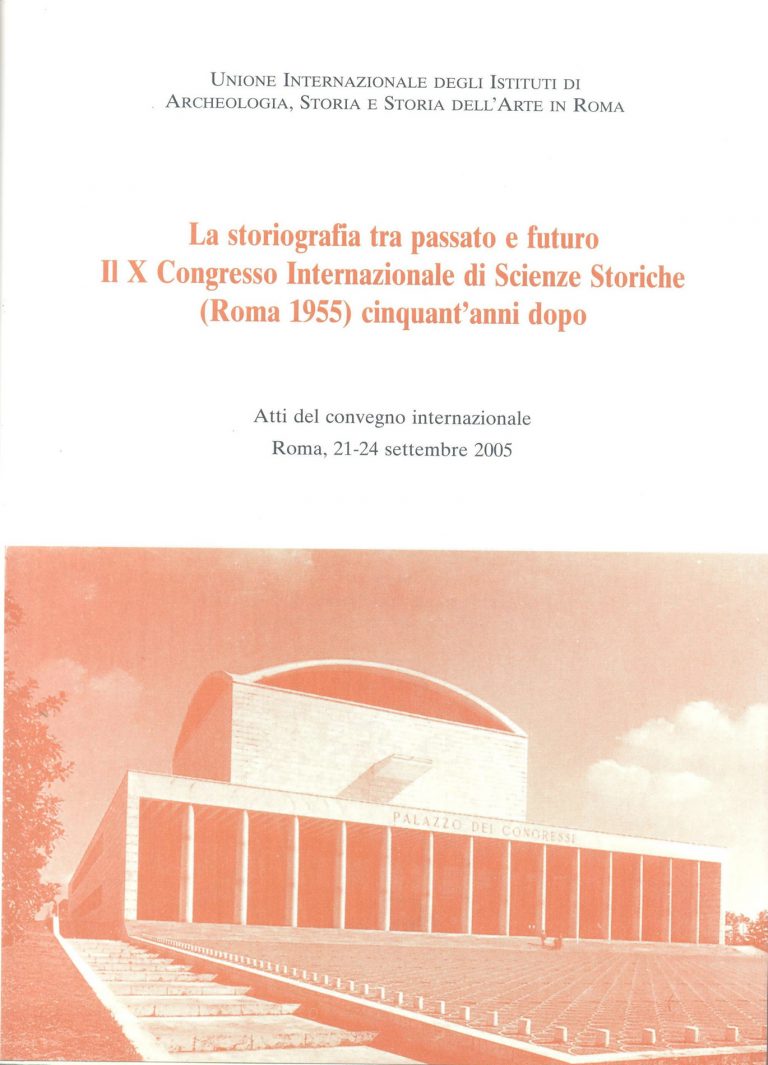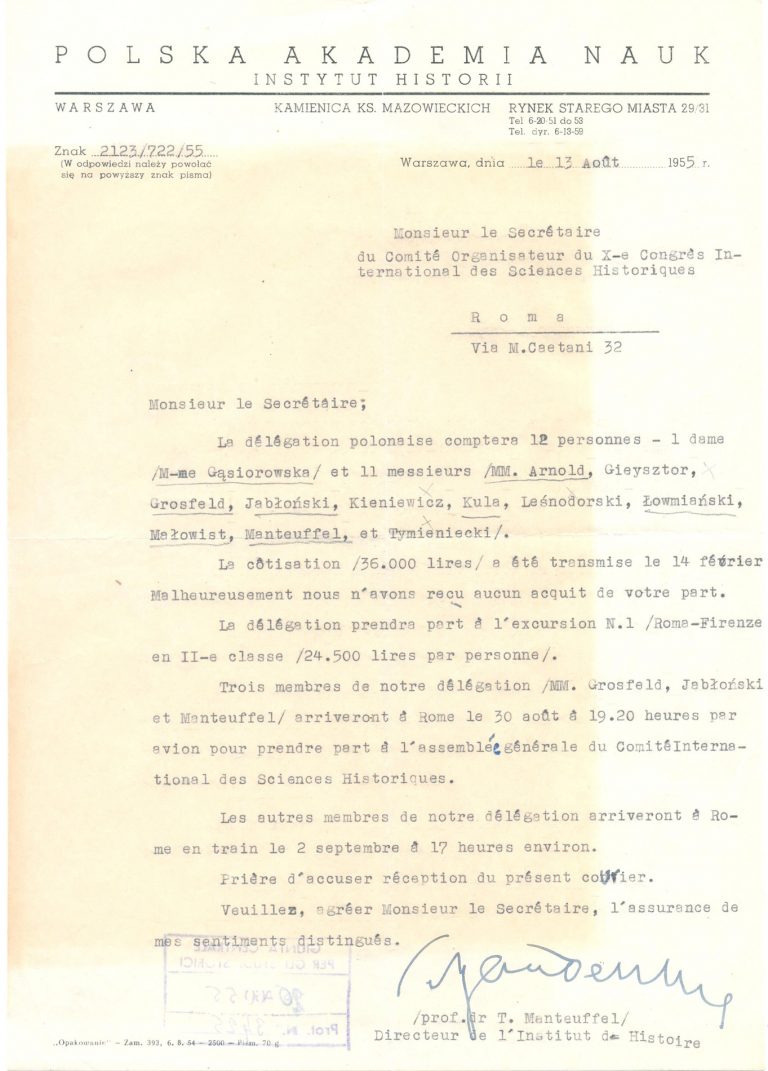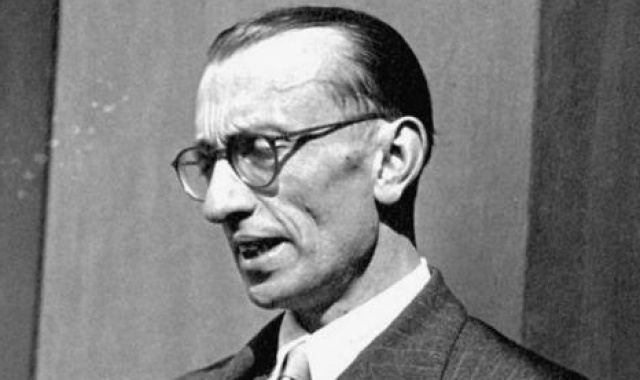The X International Congress of Historical Sciences took place in Rome on 4-11 September 1955. Its preparation was carried out first by Luigi Salvatorelli and then, after the General Assembly in Brussels in 1952, by Federico Chabod. In reply to the criticism aired by some countries, claiming that the previous Congress, held in Paris in 1950, was dominated by French historiography, this time historical committees from other countries were more actively involved in the preparation of the event.
As a result, the turnout was much higher than that in Paris. The organisers received as many as 1,633 applications. Around 1,500 scholars actually took part, 220 of whom delivered papers. The number of French historians (320) and Italians (318) was almost the same. However, the Italians had fewer papers (33 vs. 49 ones delivered by the French). Less numerous delegations included the English (212, with 25 papers), citizens of the Federal Republic of Germany (150, with 22 papers), Americans (80 and 24 papers), Yugoslavians (68, with no paper), Danes (54, with 3 papers), Belgians (53, with 5 papers), Austrians (49, with 7 papers), the Swiss (48, with 7 papers), and the Dutch (42, with 4 papers).
As to the organisation of the event, the division of active participation into papers and reports statements was retained. Unlike the preceding Congress, this one restored chronological sections, assuming that time is the key category for the historian. Faced with starting decolonisation, which led to the independence of many countries in Africa and Asia, the organisers sought to make the panels extensive enough so as not to exclude historians from outside Europe. This led to the division into four chronological sections (antiquity, middle ages, modern era, and contemporary times) and into a few additional ones, dedicated to auxiliary sciences and methodology.
The novelty of the Congress included papers summing up historical studies of the preceding decade. This task was assumed by eminent specialists: Arnaldo Momigliano for antiquity, Fernand Vercauteren (replaced by Yves Renouard) for the middle ages, Gerhard Ritter for the early modern times, and Pierre Renouvin for the contemporary times. The common denominator of all of these papers was a call for a broader historical approach, uniting into one whole political, social and economic questions. At the same time, the speakers stressed the necessity of studies not limited to a single country but transcending national borders. This appeal referred not only to the iron curtain separating the West and the East, but also to the democratic states. A fresh perspective was applied by historians from the United States (Oscar Handlin, Owen Lattimore). Referring to a theory which recognised the westwards shift of the frontier as a constitutive factor of the American people, they called for a more interdisciplinary approach.
An important topic recurrent throughout the Congress was an attempt to redefine historicism. The reference point in this respect was a reflection of Benedetto Croce, who died in 1952. According to Francesco Collotti, modern historicism should avoid the pitfalls of determinism, seeking instead universal principles of the historical process (both in the idealist and in the Marxist approach), at the same time rejecting scepticism. The scholar indicated that idea evolves along with the society and therefore the modern version of historicism was to strive to reconcile the temporary character of values with their universality.
A breakthrough of the Congress in Rome was the participation of representatives of the USSR, for the first time after the conclusion of World War II. The Soviet delegation included 13 scholars (who delivered 11 papers). They were followed by delegates from the other countries of the Eastern Bloc: Romania (27), Poland (12), Czechoslovakia (7), and Hungary (5). The arrival of guests from behind the iron curtain was possible only at the very last moment, thanks to a short period of political “thaw” following Stalin’s death. The participation of delegates from those countries was a matter of concern for the organisers, who feared fierce arguments between them and émigré historians. There were no incidents, however. The activity of the states of the socialist bloc was favourably received by both Western and Soviet press. The latter covered the event extensively and showed it as a token of intensifying collaboration between the East and the West. Still, the Soviet delegation tried to consistently and persistently emphasise faithfulness to Stalin’s historical policy. It therefore criticised the father of Soviet historiography Mikhail Pokrovsky, who was scathingly critical of tsarist imperialism, which was at variance with Stalinist attempt to restore the Soviet history to former grace. Despite the “thaw”, the historians from the USSR did get involved into ideological struggle. However, the paper of the head of the Soviet delegation, Anna Mikhailovna Pankratova, who countered the historicism of Benedetto Croce, laid bare the inadequate expertise and ossified views of Marxist historiography. Still, the dogmatism of Soviet speakers did not prevent shaping of a friendly atmosphere. The culminating point was the invitation to Moscow of the participants of a meeting preparing the next congress.
The presence of historians from the Eastern Bloc was offset by the heightened activity during the Congress of representatives of the Vatican. Not only did they participate in the preparations to the Congress, taking part in the CISH General Assembly in 1952, but they also delivered many papers during the event. One of the major events accompanying the debates themselves was an audience granted to the participants by Pope Pius XII at the Vatican. This event was extensively covered by major Italian newspapers. The address of the Holy Father explained the position of the Church towards the historical sciences and, more generally, to the challenges of the time. There was a marked change in comparison with the previous Congress in Rome held 52 years before; back then the pope had considered himself a hostage of the secular Italian state. Pius XII clearly stressed that the Church, changing through the centuries, both adopted and contributed to national culture. As the Holy Father highlighted, the Catholic Church did not identify with the European civilisation but, through the proclamation of the Gospel, was engaged in a dialogue with various cultures.
As to the Congress in Rome, the reports and papers were published in seven volumes exceptionally prior to the debates and were disseminated among the participants. The acts of the Congress came out very soon, too.
Bibliography
„Corriere della Sera”, 1955, nr 213 (8 IX)
„La Stampa”, 1955, nr 213 (8 IX)
Comitato Internazionale di Scienze Storiche. X Congresso Internazionale di Scienze Storiche, Roma 4-11 settembre 1955. Relazioni; t. 1: Metodologia – Problemi generali – Scienze ausiliarie della storia; t. 2, Storia dell’Antichità; t. 3: Storia del Medioevo; t. 4: Storia moderna; t. 5: Storia contemporanea; t. 6: Relazioni generali e supplementi, t. 7: Riassunti delle comunicazioni, Firenze 1955
Comitato Internazionale di Scienze Storiche. Atti del X Congresso Internazionale di Scienze Storiche, Roma 4-11 settembre 1955, Roma 1957
K.D. Erdmann, Die Ökumene der Historiker. Geschichte der Internationalen Historikerkongresse und des Comité International des Sciences Historiques, Göttingen 1987
P. Prodi, Il X Congresso Internazionale di Scienze Storiche. Roma 1955. Cinquant’anni di distanza, [w:] Il X Congresso Internazionale di Scienze Storiche. Roma 1955. Cinquant’anni di distanza. Atti del convegno internazionale Roma, 21-24 settembre 2005, ed. Manuel Espadas Burgos, M. Gras, M. Matheus, M. Miglio, Roma 2008, s. 9-23
Andrea Mariani









